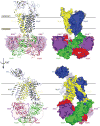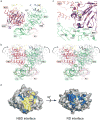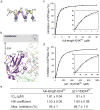Carbon catabolite repression of the maltose transporter revealed by X-ray crystallography
- PMID: 23770568
- PMCID: PMC3875231
- DOI: 10.1038/nature12232
Carbon catabolite repression of the maltose transporter revealed by X-ray crystallography
Abstract
Efficient carbon utilization is critical to the survival of microorganisms in competitive environments. To optimize energy usage, bacteria have developed an integrated control system to preferentially uptake carbohydrates that support rapid growth. The availability of a preferred carbon source, such as glucose, represses the synthesis and activities of proteins necessary for the transport and metabolism of secondary carbon sources. This regulatory phenomenon is defined as carbon catabolite repression. In enteric bacteria, the key player of carbon catabolite repression is a component of the glucose-specific phosphotransferase system, enzyme IIA (EIIA(Glc)). It is known that unphosphorylated EIIA(Glc) binds to and inhibits a variety of transporters when glucose is available. However, understanding the underlying molecular mechanism has been hindered by the complete absence of structures for any EIIA(Glc)-transporter complexes. Here we present the 3.9 Å crystal structure of Escherichia coli EIIA(Glc) in complex with the maltose transporter, an ATP-binding cassette (ABC) transporter. The structure shows that two EIIA(Glc) molecules bind to the cytoplasmic ATPase subunits, stabilizing the transporter in an inward-facing conformation and preventing the structural rearrangements necessary for ATP hydrolysis. We also show that the half-maximal inhibitory concentrations of the full-length EIIA(Glc) and an amino-terminal truncation mutant differ by 60-fold, consistent with the hypothesis that the amino-terminal region, disordered in the crystal structure, functions as a membrane anchor to increase the effective EIIA(Glc) concentration at the membrane. Together these data suggest a model of how the central regulatory protein EIIA(Glc) allosterically inhibits maltose uptake in E. coli.
Figures




Similar articles
-
Topography of the surface of the signal-transducing protein EIIA(Glc) that interacts with the MalK subunits of the maltose ATP-binding cassette transporter (MalFGK2) of Salmonella typhimurium.J Biol Chem. 2006 May 5;281(18):12833-40. doi: 10.1074/jbc.M512646200. Epub 2006 Mar 9. J Biol Chem. 2006. PMID: 16527815
-
Phosphatidylglycerol directs binding and inhibitory action of EIIAGlc protein on the maltose transporter.J Biol Chem. 2013 Aug 16;288(33):23666-74. doi: 10.1074/jbc.M113.489567. Epub 2013 Jul 2. J Biol Chem. 2013. PMID: 23821551 Free PMC article.
-
Mode of Interaction of the Signal-Transducing Protein EIIA(Glc) with the Maltose ABC Transporter in the Process of Inducer Exclusion.Biochemistry. 2016 Sep 27;55(38):5442-52. doi: 10.1021/acs.biochem.6b00721. Epub 2016 Sep 19. Biochemistry. 2016. PMID: 27571040
-
Molecular mechanism of the Escherichia coli maltose transporter.Curr Opin Struct Biol. 2013 Aug;23(4):492-8. doi: 10.1016/j.sbi.2013.03.011. Epub 2013 Apr 27. Curr Opin Struct Biol. 2013. PMID: 23628288 Free PMC article. Review.
-
Carbohydrate Transport by Group Translocation: The Bacterial Phosphoenolpyruvate: Sugar Phosphotransferase System.Subcell Biochem. 2019;92:223-274. doi: 10.1007/978-3-030-18768-2_8. Subcell Biochem. 2019. PMID: 31214989 Review.
Cited by
-
Mechanisms of membrane protein crystallization in 'bicelles'.Sci Rep. 2022 Jun 30;12(1):11109. doi: 10.1038/s41598-022-13945-0. Sci Rep. 2022. PMID: 35773455 Free PMC article.
-
Allosteric regulation of nitrate transporter NRT via the signaling protein PII.Proc Natl Acad Sci U S A. 2024 Mar 12;121(11):e2318320121. doi: 10.1073/pnas.2318320121. Epub 2024 Mar 8. Proc Natl Acad Sci U S A. 2024. PMID: 38457518 Free PMC article.
-
Biodegradation of 2-hydroxyl-1,4 naphthoquinone (lawsone) by Pseudomonas taiwanensis LH-3 isolated from activated sludge.Sci Rep. 2017 Jul 28;7(1):6795. doi: 10.1038/s41598-017-06338-1. Sci Rep. 2017. PMID: 28754900 Free PMC article.
-
Thermodynamic mechanism for inhibition of lactose permease by the phosphotransferase protein IIAGlc.Proc Natl Acad Sci U S A. 2015 Feb 24;112(8):2407-12. doi: 10.1073/pnas.1500891112. Epub 2015 Feb 9. Proc Natl Acad Sci U S A. 2015. PMID: 25675534 Free PMC article.
-
Structural insight into the PTS sugar transporter EIIC.Biochim Biophys Acta. 2015 Mar;1850(3):577-85. doi: 10.1016/j.bbagen.2014.03.013. Epub 2014 Mar 20. Biochim Biophys Acta. 2015. PMID: 24657490 Free PMC article. Review.
References
-
- Gorke B, Stulke J. Carbon catabolite repression in bacteria: many ways to make the most out of nutrients. Nat Rev Microbiol. 2008;6:613–624. - PubMed
-
- Wang G, Peterkofsky A, Clore GM. A novel membrane anchor function for the N-terminal amphipathic sequence of the signal-transducing protein IIAGlucose of the Escherichia coli phosphotransferase system. J Biol Chem. 2000;275:39811–39814. - PubMed
-
- Hogema BM, et al. Inducer exclusion in Escherichia coli by non-PTS substrates: the role of the PEP to pyruvate ratio in determining the phosphorylation state of enzyme IIAGlc. Mol Microbiol. 1998;30:487–498. - PubMed
Publication types
MeSH terms
Substances
Associated data
- Actions
Grants and funding
LinkOut - more resources
Full Text Sources
Other Literature Sources
Molecular Biology Databases

